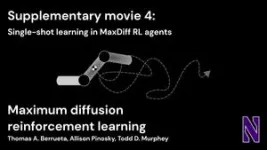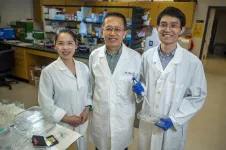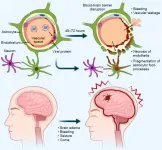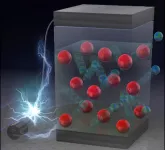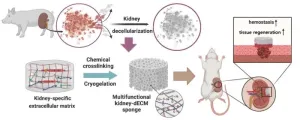(Press-News.org)
Northwestern University engineers have developed a new artificial intelligence (AI) algorithm designed specifically for smart robotics. By helping robots rapidly and reliably learn complex skills, the new method could significantly improve the practicality — and safety — of robots for a range of applications, including self-driving cars, delivery drones, household assistants and automation.
Called Maximum Diffusion Reinforcement Learning (MaxDiff RL), the algorithm’s success lies in its ability to encourage robots to explore their environments as randomly as possible in order to gain a diverse set of experiences. This “designed randomness” improves the quality of data that robots collect regarding their own surroundings. And, by using higher-quality data, simulated robots demonstrated faster and more efficient learning, improving their overall reliability and performance.
When tested against other AI platforms, simulated robots using Northwestern’s new algorithm consistently outperformed state-of-the-art models. The new algorithm works so well, in fact, that robots learned new tasks and then successfully performed them within a single attempt — getting it right the first time. This starkly contrasts current AI models, which enable slower learning through trial and error.
The research will be published on Thursday (May 2) in the journal Nature Machine Intelligence.
“Other AI frameworks can be somewhat unreliable,” said Northwestern’s Thomas Berrueta, who led the study. “Sometimes they will totally nail a task, but, other times, they will fail completely. With our framework, as long as the robot is capable of solving the task at all, every time you turn on your robot you can expect it to do exactly what it’s been asked to do. This makes it easier to interpret robot successes and failures, which is crucial in a world increasingly dependent on AI.”
Berrueta is a Presidential Fellow at Northwestern and a Ph.D. candidate in mechanical engineering at the McCormick School of Engineering. Robotics expert Todd Murphey, a professor of mechanical engineering at McCormick and Berrueta’s adviser, is the paper’s senior author. Berrueta and Murphey co-authored the paper with Allison Pinosky, also a Ph.D. candidate in Murphey’s lab.
The disembodied disconnect
To train machine-learning algorithms, researchers and developers use large quantities of big data, which humans carefully filter and curate. AI learns from this training data, using trial and error until it reaches optimal results. While this process works well for disembodied systems, like ChatGPT and Google Gemini (formerly Bard), it does not work for embodied AI systems like robots. Robots, instead, collect data by themselves — without the luxury of human curators.
“Traditional algorithms are not compatible with robotics in two distinct ways,” Murphey said. “First, disembodied systems can take advantage of a world where physical laws do not apply. Second, individual failures have no consequences. For computer science applications, the only thing that matters is that it succeeds most of the time. In robotics, one failure could be catastrophic.”
To solve this disconnect, Berrueta, Murphey and Pinosky aimed to develop a novel algorithm that ensures robots will collect high-quality data on-the-go. At its core, MaxDiff RL commands robots to move more randomly in order to collect thorough, diverse data about their environments. By learning through self-curated random experiences, robots acquire necessary skills to accomplish useful tasks.
Getting it right the first time
To test the new algorithm, the researchers compared it against current, state-of-the-art models. Using computer simulations, the researchers asked simulated robots to perform a series of standard tasks. Across the board, robots using MaxDiff RL learned faster than the other models. They also correctly performed tasks much more consistently and reliably than others.
Perhaps even more impressive: Robots using the MaxDiff RL method often succeeded at correctly performing a task in a single attempt. And that’s even when they started with no knowledge.
“Our robots were faster and more agile — capable of effectively generalizing what they learned and applying it to new situations,” Berrueta said. “For real-world applications where robots can’t afford endless time for trial and error, this is a huge benefit.”
Because MaxDiff RL is a general algorithm, it can be used for a variety of applications. The researchers hope it addresses foundational issues holding back the field, ultimately paving the way for reliable decision-making in smart robotics.
“This doesn’t have to be used only for robotic vehicles that move around,” Pinosky said. “It also could be used for stationary robots — such as a robotic arm in a kitchen that learns how to load the dishwasher. As tasks and physical environments become more complicated, the role of embodiment becomes even more crucial to consider during the learning process. This is an important step toward real systems that do more complicated, more interesting tasks.”
The study, “Maximum diffusion reinforcement learning,” was supported by the U.S. Army Research Office (grant number W911NF-19-1-0233) and the U.S. Office of Naval Research (grant number N00014-21-1-2706).
END
Play is widespread, but far from ubiquitous, across the animal kingdom. Especially common in mammals, play is also known to occur in taxa as diverse as birds, fish, octopuses, and even insects. But what is its function, given that natural selection never selects fun for its own sake? One prominent hypothesis is that play is beneficial to individuals because it allows them to practice skills needed later in life.
Now, a study in Frontiers in Ethology has shown that male baby chickens play far more than females. This result is of interest given that domestic ...
Osaka, Japan – Probiotics offer a range of health benefits, but their adverse effects can occasionally lead to bacteremia, wherein bacteria circulate in the bloodstream throughout the body. In Japan, Clostridium butyricum (C. butyricum) MIYAIRI 588 is commonly used, yet the prevalence and characteristics of bacteremia caused by this strain, as well as its bacteriological and genetic profile, remain unknown.
A research team from the Graduate School of Medicine, Osaka University, found an association between bacteremia and probiotics from a study of the genetic materials of bacteria in hospitalized patients with bacteremia.
From September 2011 to February 2023, ...
Medical College of Georgia scientists report that a gene previously implicated in the development of atherosclerotic lesions in coronary arteries could be key to understanding why many people don’t benefit from the most used therapy for neovascular age-related macular degeneration (AMD), a leading cause of blindness.
AMD is a condition characterized by abnormal blood vessel growth in the back of the eye. It is highly prevalent in the elderly and people with diabetes, obesity, and many other chronic metabolic diseases. Excessive vascular growth damages the macula, the part of the eye that translates light into image signals.
Anti-VEGF therapy, which blocks vascular ...
Osaka, Japan – It might start simply, with a cough or sneeze…but in some cases, the flu virus can make its way to your brain, causing serious symptoms or even death through a disease known as influenza-associated encephalopathy (IAE).
Now, in a study published in Acta Neuropathologica, researchers have revealed that IAE may be caused by the virus entering the brain through a specific cell type, and have identified possible treatment strategies.
Although IAE is increasingly common, surprisingly little is known about ...
In the shadowy world of counterfeit alcoholic spirit production, where profits soar and brands are exploited, the true extent of this illegal market remains shrouded.
Now scientists from the International Centre for Brewing and Distilling (ICBD) at Heriot-Watt University, in Edinburgh, Scotland, working alongside Dr John Edwards of Process NMR Associates, based in New York, are compiling a database to test, compare and log counterfeit spirits.
The research has featured in a paper, titled, Worldwide Illicit and Counterfeit ...
Charge-recharge cycling of lithium-superrich iron oxide, a cost-effective and high-capacity cathode for new-generation lithium-ion batteries, can be greatly improved by doping with readily available mineral elements.
The energy capacity and charge-recharge cycling (cyclability) of lithium-iron-oxide, a cost-effective cathode material for rechargeable lithium-ion batteries, is improved by adding small amounts of abundant elements. The development, achieved by researchers at Hokkaido University, Tohoku University, and Nagoya Institute of Technology, is reported in the journal ACS Materials Letters.
Lithium-ion batteries have become indispensable in modern life, used in a multitude ...
CORVALLIS, Ore. – Artificial intelligence analysis of data gathered by acoustic recording devices is a promising new tool for monitoring the marbled murrelet and other secretive, hard-to-study species, research by Oregon State University and the U.S. Forest Service has shown.
The threatened marbled murrelet is an iconic Pacific Northwest seabird that’s closely related to puffins and murres, but unlike those birds, murrelets raise their young as far as 60 miles inland in mature and old-growth forests.
“There are very few species like it,” said co-author Matt Betts of the OSU College of Forestry. “And there’s no ...
Professor Dong-Woo Cho from the Department of Mechanical Engineering along with Jae Yun Kim, a PhD candidate, from the School of Interdisciplinary Bioscience and Bioengineering and Tugce Sen, a PhD student, from Department of Mechanical Engineering at POSTECH, teamed up with Professor Jae Yeon Lee from Daegu Haany University's Department of Companion Animal Health. Together, they crafted a material aimed at swiftly staunching kidney bleeding and facilitating wound recovery. Their research featured in the online edition of Biomaterials, an ...
MIAMI, FLORIDA (May 1, 2024) – Patients in South Florida with metastatic melanoma will soon have access to the first cellular therapy for this advanced form of skin cancer, following its recent approval by the Food and Drug Administration (FDA). The therapy, known as tumor-infiltrating lymphocyte therapy, or TIL, uses patients’ own immune cells to battle their cancer. It will be available to patients at Sylvester Comprehensive Cancer Center at the University of Miami Miller School of Medicine as South Florida’s only center offering ...
A recent study led by UC Davis Health researchers provides new insights into the molecular changes linked to the rare genetic condition 22q11.2 deletion syndrome, or 22q. It found unique biomarkers that could identify patients with 22q who may be more likely to develop schizophrenia or psychiatric conditions, including psychosis, which is commonly associated with 22q. The research was published in the journal Metabolomics.
People with 22q are missing a piece of chromosome 22 that contains more than 30 genes. This loss can lead to a variety of health challenges, ...


